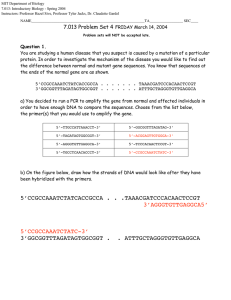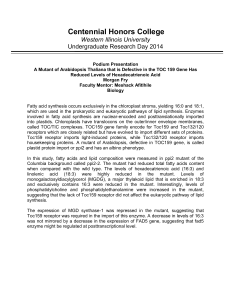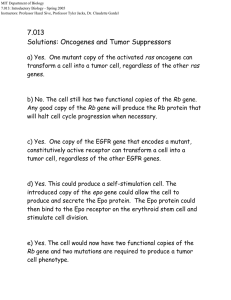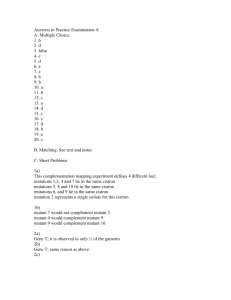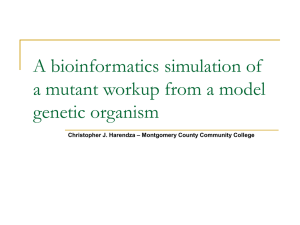MIT Department of Biology 7.013: Introductory Biology - Spring 2004
advertisement
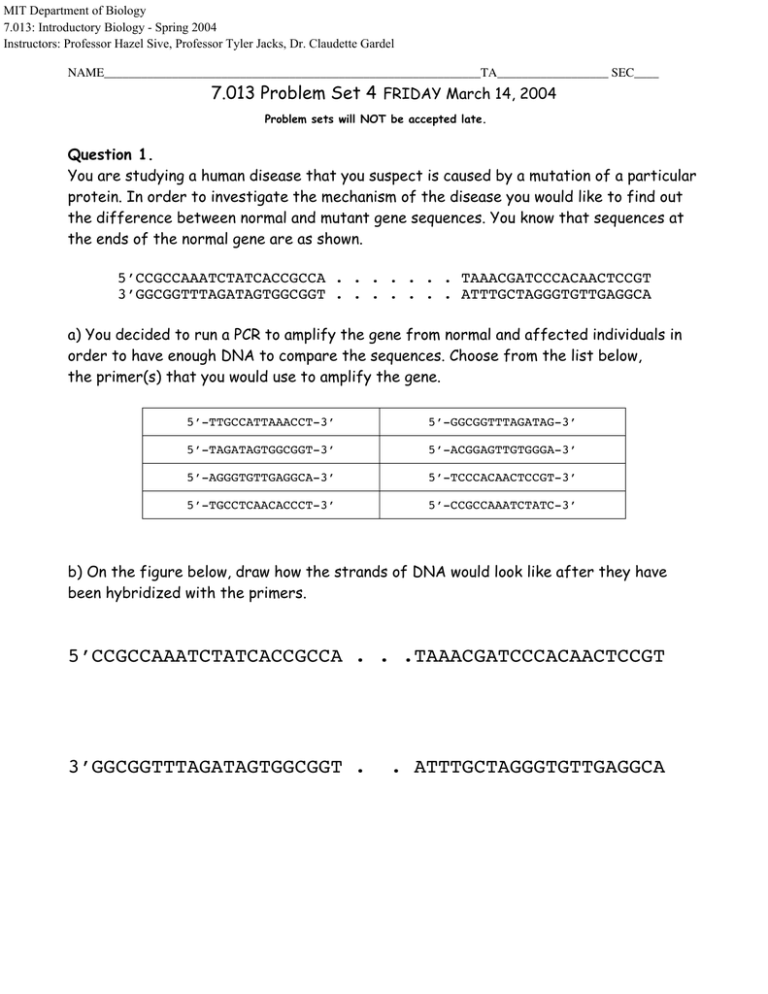
MIT Department of Biology 7.013: Introductory Biology - Spring 2004 Instructors: Professor Hazel Sive, Professor Tyler Jacks, Dr. Claudette Gardel NAME_____________________________________________________________TA__________________ SEC____ 7.013 Problem Set 4 FRIDAY March 14, 2004 Problem sets will NOT be accepted late. Question 1. You are studying a human disease that you suspect is caused by a mutation of a particular protein. In order to investigate the mechanism of the disease you would like to find out the difference between normal and mutant gene sequences. You know that sequences at the ends of the normal gene are as shown. 5’CCGCCAAATCTATCACCGCCA . . . . . . . TAAACGATCCCACAACTCCGT 3’GGCGGTTTAGATAGTGGCGGT . . . . . . . ATTTGCTAGGGTGTTGAGGCA a) You decided to run a PCR to amplify the gene from normal and affected individuals in order to have enough DNA to compare the sequences. Choose from the list below, the primer(s) that you would use to amplify the gene. 5’-TTGCCATTAAACCT-3’ 5’-GGCGGTTTAGATAG-3’ 5’-TAGATAGTGGCGGT-3’ 5’-ACGGAGTTGTGGGA-3’ 5’-AGGGTGTTGAGGCA-3’ 5’-TCCCACAACTCCGT-3’ 5’-TGCCTCAACACCCT-3’ 5’-CCGCCAAATCTATC-3’ b) On the figure below, draw how the strands of DNA would look like after they have been hybridized with the primers. 5’CCGCCAAATCTATCACCGCCA . . .TAAACGATCCCACAACTCCGT 3’GGCGGTTTAGATAGTGGCGGT . . ATTTGCTAGGGTGTTGAGGCA After amplifying the DNA with your primers, you run PCR products on an acrylamide gel and find that amplification products derived from normal and affected individuals run at different positions on a gel. WT mutant 500 368 342 311 268 167 c) What kind of mutation could the mutant gene have? _______________________ To confirm your suspicion you decide to sequence both of your PCR products. A portion of the sequencing gel shows the following pattern. WT ddA ddC ddG ddT Mutant ddA ddC ddG ddT d) Write out the wild type and mutant sequences shown above. Show the 5’ and 3’ designations. State the type of mutation and compare this result with your answer in c). WT: MUT: 2 Question 2 Consider two proteins- a transcription factor (nuclear protein) and a hormone receptor (membrane-spanning protein). Protein 1: transcription factor NH3 COO- Protein 2: Hormone Receptor NH3 COO- a) What is the difference between protein localization sequences in proteins 1 and 2 such that they are targeted to different cell compartments? b) Indicate where you would expect to find proteins 1 and 2 in a cell that has a mutated signal recognition particle (SRP). Explain why proteins would be found in these locations. c) Indicate the correct sequence of events that will lead to the proper localization of proteins 1 and 2. (This question refers to pages 231-234 inPurves.) 1. Protein synthesis is blocked by SRP 2. After removal of signal sequence, growing polypeptide enters ER 3. Glycosylation occurs 4. Protein is anchored in plasma membrane 5. Translation of polypeptide chain starts in the cytoplasm on the ribosome 6. Protein synthesis resumes 7. Protein is transported to Golgi in a vesicle 8. SRP attaches to a specific receptor on the ER 9. Growing polypeptide becomes embedded in ER membrane. 10. Vesicle harboring protein buds off Golgi 11. Protein enters nucleus 12. Signal sequence is removed 13. SRP binds signal sequence 14. Vesicle fuses with the plasma membrane 15. Signal sequence binds to receptor on nucleus opening channel PROTEIN 1: PROTEIN 2: 3 Question 3 Epinephrine or adrenalin is the hormone involved in the fight or flight response. If you were to watch a scary movie or you were to be startled while walking on a darkened street, your adrenal medulla would secrete epinephrine. Epinephrine binding stimulates heterotrimeric G-protein coupled receptors that lead to signal cascades that prevent glucose storage in the form of glycogen and in turn promotes glucose release through glycogen breakdown. Release of glucose into the blood provides quick energy for “fight or flight”. The liver is where most of the glycogen is stored and so liver cells have many epinephrine receptors. a) In the liver cell below, diagram this signal transduction pathway starting with epinephrine binding and ending with the release of glucose. Include the following components into your diagram: epinephrine, epinephrine receptor, the subunits of heterotrimeric G-protein, adenylate cyclase, cAMP, GTP/GDP, ATP/ADP, PKA (Protein Kinase A), phosphorylase kinase, glycogen phosphorylase, glycogen synthase, and glucose. Liver Cell Plasma Membrane b) Indicate two steps in this pathway where signal amplification occurs. 4 Question 4 You are interested in studying the eukaryotic cell cycle. You choose yeast as your model organism because it is a eukaryote and easy to manipulate. You are going to work with the haploid form of yeast in these experiments. One of the methods to study essential functions in cells (examples: protein secretion and cell division) involves the use of conditional lethal or temperature-sensitive mutants. These mutants have a protein that becomes defective at a higher or lower temperature and yet is functional at 25°C. You have isolated a temperature-sensitive cell division cycle (cdc) yeast mutant that you call cdc-101. These mutant cells grow normally at the permissive temperature (25°C). However when the temperature is shifted to 36°C (nonpermissive temperature), these cells arrest at a specific point in the cell cycle (as a direct result of the loss of function of their mutant protein). You would like to determine at which point of the cell cycle the expression of the cdc-101 gene is required. Two chemicals that arrest cells at different stages of the cycle are listed here. nocodozole arrests cells in mitosis (M phase). G2 hydroxyurea blocks DNA synthesis. M G1 S Figure by MIT OCW. You perform the following experiment. Experiment 1 You grow cdc-101 (mutant) cells at permissive temperature (25°C) in the presence of nocodozole (until they arrest). Then you shift the arrested cells to the nonpermissive temperature (36°C) and remove the nocodazole. You observe that the cells divide once and then are arrested in the cell cycle. a) What does this experiments tell about the phase of the cell cycle where the expression of the cdc-101 protein is required? 5 You would like to narrow down the time when the cdc-101 gene product is essential. In order to solve this problem you perform two more experiments. Experiment 2 You grow cdc-101 cells at the permissive temperature (25°C) in the presence of hydroxyurea till all cells are arrested, then you shift cells to 36°C and remove the drug. You observe that the cells arrest without dividing. Experiment 3 You grow cdc-101 cells at 36°C until they arrest at their specific point in the cell cycle, then you shift them to 25°C and add hydroxyurea. You observe the cells divide once before arresting again. b) What can you conclude when the gene product of cdc-101 is required in the cell cycle? Question 5 a) On a sunny day everyone likes to go to the beach. Although one has to be really careful, too much sun can cause serious sunburns and in a few days the upper layer of the skin peels off. Due to which cellular process does the upper skin layer peel off? Explain your answer. b) Give an example of the disease caused by the defect in the same cellular process. c) Is this disease caused by a lack or an excess of this cellular process? d) Define the following terms with respect to development. FatePotency – UnipotentTotipotentDeterminantInducer6
